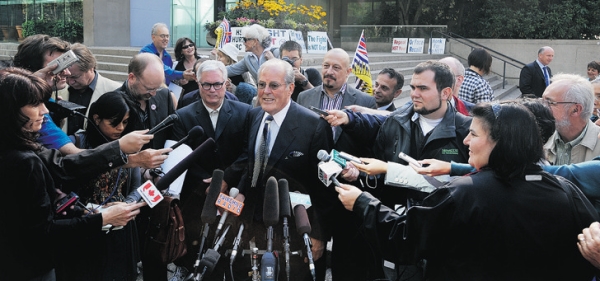Two million reasons for high prices
Don Cayo
Sun

The buzz that lures people to the decks and patios of Yaletown keeps the region’s housing prices zooming up. The high prices, however, are putting pressure on the city’s creative class, which is packing up and heading for cheaper cities. Photograph by: Glenn Baglo, Vancouver Sun
What drives Vancouver’s house prices so relentlessly to levels four times higher than Winnipeg’s, and more than half again what Torontonians pay?
It’s simple, says Tsur Somerville of UBC Centre for Urban Economics and Real Estate.
“If you want Winnipeg-level house prices here, all you have to do is tear down the mountains and fill in the ocean.”
Well, that puts slow or stop to the steady influx of people — though the massive loss of amenities if our landscape were to be suddenly levelled might do that automatically.
“Depending where you draw the circle,” Somerville says, “70 per cent of the land isn’t developable. It’s mountains or water or the United States.”
Then, on top of this insurmountable geographic limitation, add the relentless population growth that, in good years and in bad, ranges from 1.3 to 1.5 per cent a year.
“The higher the population of a city, the higher the house prices,” he says. “If we lose 70 per cent of the land, our metropolitan area of two million will have the same house prices as a seven-million metropolitan area. Because people have to commute the same distance.”
The myths
Does this mean there’s no truth to some, or all, of the pervasive myths? You know, the ones that maintain our housing costs are driven by rich immigrants looking to get families and/or mistresses out of Hong Kong or other Asian cities. Or by criminals laundering ill-gotten gains. Or speculators. Or empty nesters who reap big tax incentives to not budge from big houses on the best land. Or all that acreage tied up in parks and the Agricultural Land Reserve. Or the rules and fees imposed on developers. Or the property transfer tax on all home sales, and the HST on new ones. Or the civic amenities for which buyers pay through the nose. Or imprudent young buyers willing to take on massive debt. Or an inherent result of a good economy. Or ….
One reader even suggests it’s the fault of public employees, who are so numerous and so well paid they over-invest in property. And an academic study on my desk argues it’s the high hidden cost of the city’s ubiquitous “free” parking.
This short series will look at several of these myths, which collectively point one finger or another at most Metro residents, no matter which group we fall into. The conclusion is, in short, that many of them are, like all good myths, rooted in a little truth. But none come close to matching the impact of the Law of Supply and Demand.
“That’s why, even if the economy collapses, house prices don’t tank,” says Jock Finlayson of the B.C. Business Council. “You get some drop, but it’s typically modest because there’s a growing population and there just isn’t a lot of land.”
Maintaining demand
What helps maintain this demand, says Cameron Muir
of the Real Estate Council of BC, is that much of the population growth stems from international immigration, and it, unlike internal migration, tends not to follow the business cycle.
“When the economy is performing weakly, immigrants still come,” Muir says. “This not only bolsters our population, but also housing demand.”
And: “Our immigrants tend to be the cream of the crop,” Muir says, citing statistics showing 55 per cent of Canada’s investor immigrants come to B.C., mostly to Metro Vancouver.
But for people already here and newcomers who don’t arrive with money, Finlayson notes, “Incomes aren’t that high here. They’re less than in Calgary, Edmonton, Toronto, Ottawa or London, Ontario. But our houses cost a lot more. So people cope by getting less house. They commute farther than they would in another community. Or they get less space than they would settle for in another city.
“They live in condominiums and raise children, which is not common in other parts of the country.”
Or, in the case of a growing number of young people, they’re coping in a far more worrisome way, says Andy Yan, a planner and researcher with Bing Thom Architects.
Yan has looked at what’s happened with housing in a few other high-priced cities.
In Hong Kong, which ironically is seen as a bastion of free enterprise, 60 per cent of the people live in government-subsidized housing, he said.
On the other hand, prices in San Francisco shot so high that demand has flattened or even decreased over the last 20 years, and huge numbers of the city’s workers live somewhere else and commute in daily.
Two-thirds of Metro’s people also live outside the City of Vancouver, though we haven’t yet hit the downward pressure on price seen in San Francisco.
Instead, Yan sees a lot of young Vancouverites, especially those who have an artistic bent and who thrive on the energy of a vibrant city core, packing up to leave for Montreal or Toronto simply because it’s cheaper to live there and pursue creative goals.
“Because Vancouver is going through a very destructive real estate market,” he says.
“High housing costs have a great way of killing innovation and creativity. Can the next Facebook or the next Apple computer really come from Vancouver if you’re too busy trying to pay the rent?”
The upshot, he says, is that Vancouver is increasingly seen by the young as a nice place to hang out for a couple of years, but not a place to settle down.
“That’s serious. You’ve got to think about what’s down the road. They’re not going to be here to support us, to pay for our social infrastructure and all of that.”
© Copyright (c) The Vancouver Sun










